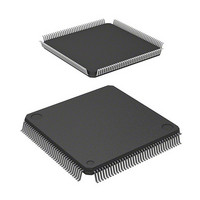R4F24569NVFQV Renesas Electronics America, R4F24569NVFQV Datasheet - Page 1039

R4F24569NVFQV
Manufacturer Part Number
R4F24569NVFQV
Description
MCU 256KB FLASH 64K 144-LQFP
Manufacturer
Renesas Electronics America
Series
H8® H8S/2400r
Specifications of R4F24569NVFQV
Core Processor
H8S/2600
Core Size
16/32-Bit
Speed
32MHz
Connectivity
EBI/EMI, I²C, IrDA, SCI, SSU, UART/USART, USB
Peripherals
DMA, POR, PWM, WDT
Number Of I /o
96
Program Memory Size
256KB (256K x 8)
Program Memory Type
FLASH
Ram Size
64K x 8
Voltage - Supply (vcc/vdd)
3 V ~ 3.6 V
Data Converters
A/D 16x10b; D/A 2x8b
Oscillator Type
External
Operating Temperature
-20°C ~ 75°C
Package / Case
144-LQFP
Lead Free Status / RoHS Status
Lead free / RoHS Compliant
Eeprom Size
-
Available stocks
Company
Part Number
Manufacturer
Quantity
Price
Company:
Part Number:
R4F24569NVFQV
Manufacturer:
Renesas Electronics America
Quantity:
135
Company:
Part Number:
R4F24569NVFQV
Manufacturer:
Renesas Electronics America
Quantity:
10 000
- Current page: 1039 of 1426
- Download datasheet (8Mb)
H8S/2456, H8S/2456R, H8S/2454 Group
16.7
16.7.1
This section describes stall operations in this module. There are two cases in which the USB
function module stall function is used:
• When the application forcibly stalls an endpoint for some reason
• When a stall is performed automatically within the USB function module due to a USB
The USB function module has internal status bits that hold the status (stall or non-stall) of each
endpoint. When a transaction is sent from the host, the module references these internal status bits
and determines whether to return a stall to the host. These bits cannot be cleared by the
application; they must be cleared with a Clear Feature command from the host.
However, the internal status bit for EP0 is automatically cleared only when the setup command is
received.
16.7.2
The application uses the EPSTL register to issue a stall request for the USB function module.
When the application wishes to stall a specific endpoint, it sets the corresponding bit in EPSTL (1-
1 in figure 16.19). The internal status bits are not changed at this time. When a transaction is sent
from the host for the endpoint for which the EPSTL bit was set, the USB function module
references the internal status bit, and if this is not set, references the corresponding bit in EPSTL
(1-2 in figure 16.19). If the corresponding bit in EPSTL is set, the USB function module sets the
internal status bit and returns a stall handshake to the host (1-3 in figure 16.19). If the
corresponding bit in EPSTL is not set, the internal status bit is not changed and the transaction is
accepted.
Once an internal status bit is set, it remains set until cleared by a Clear Feature command from the
host, without regard to the EPSTL register. Even after a bit is cleared by the Clear Feature
command (3-1 in figure 16.19), the USB function module continues to return a stall handshake
while the bit in EPSTL is set, since the internal status bit is set each time a transaction is executed
for the corresponding endpoint (1-2 in figure 16.19). To clear a stall, therefore, it is necessary for
the corresponding bit in EPSTL to be cleared by the application, and also for the internal status bit
to be cleared with a Clear Feature command (2-1, 2-2, and 2-3 in figure 16.19).
REJ09B0467-0350 Rev. 3.50
Jul 07, 2010
specification violation
Stall Operations
Overview
Forcible Stall by Application
Section 16 USB Function Module (USB)
Page 1009 of 1392
Related parts for R4F24569NVFQV
Image
Part Number
Description
Manufacturer
Datasheet
Request
R

Part Number:
Description:
KIT STARTER FOR M16C/29
Manufacturer:
Renesas Electronics America
Datasheet:

Part Number:
Description:
KIT STARTER FOR R8C/2D
Manufacturer:
Renesas Electronics America
Datasheet:

Part Number:
Description:
R0K33062P STARTER KIT
Manufacturer:
Renesas Electronics America
Datasheet:

Part Number:
Description:
KIT STARTER FOR R8C/23 E8A
Manufacturer:
Renesas Electronics America
Datasheet:

Part Number:
Description:
KIT STARTER FOR R8C/25
Manufacturer:
Renesas Electronics America
Datasheet:

Part Number:
Description:
KIT STARTER H8S2456 SHARPE DSPLY
Manufacturer:
Renesas Electronics America
Datasheet:

Part Number:
Description:
KIT STARTER FOR R8C38C
Manufacturer:
Renesas Electronics America
Datasheet:

Part Number:
Description:
KIT STARTER FOR R8C35C
Manufacturer:
Renesas Electronics America
Datasheet:

Part Number:
Description:
KIT STARTER FOR R8CL3AC+LCD APPS
Manufacturer:
Renesas Electronics America
Datasheet:

Part Number:
Description:
KIT STARTER FOR RX610
Manufacturer:
Renesas Electronics America
Datasheet:

Part Number:
Description:
KIT STARTER FOR R32C/118
Manufacturer:
Renesas Electronics America
Datasheet:

Part Number:
Description:
KIT DEV RSK-R8C/26-29
Manufacturer:
Renesas Electronics America
Datasheet:

Part Number:
Description:
KIT STARTER FOR SH7124
Manufacturer:
Renesas Electronics America
Datasheet:

Part Number:
Description:
KIT STARTER FOR H8SX/1622
Manufacturer:
Renesas Electronics America
Datasheet:

Part Number:
Description:
KIT DEV FOR SH7203
Manufacturer:
Renesas Electronics America
Datasheet:











